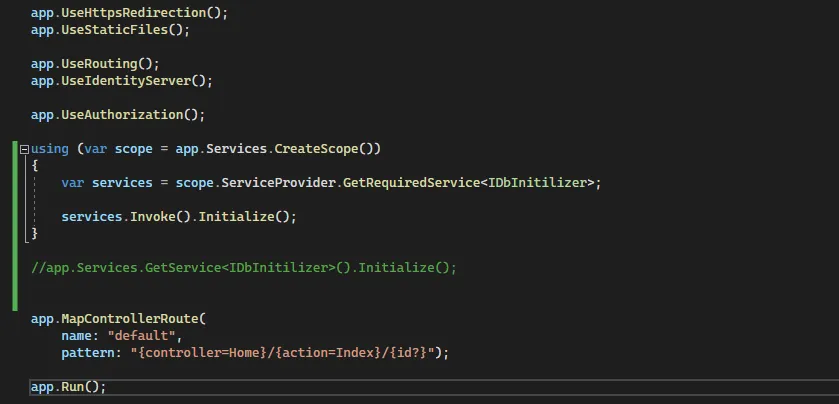当我尝试运行我的应用程序时,出现错误
InvalidOperationException: Cannot resolve 'API.Domain.Data.Repositories.IEmailRepository' from root provider because it requires scoped service 'API.Domain.Data.EmailRouterContext'.
奇怪的是,就我所知,这个EmailRepository和接口与我所有其他的存储库完全相同,但对它们不会抛出任何错误。只有在我尝试使用app.UseEmailingExceptionHandling();行时才会发生错误。以下是我的Startup.cs文件的一部分。
public class Startup
{
public IConfiguration Configuration { get; protected set; }
private APIEnvironment _environment { get; set; }
public Startup(IConfiguration configuration, IHostingEnvironment env)
{
Configuration = configuration;
_environment = APIEnvironment.Development;
if (env.IsProduction()) _environment = APIEnvironment.Production;
if (env.IsStaging()) _environment = APIEnvironment.Staging;
}
public void ConfigureServices(IServiceCollection services)
{
var dataConnect = new DataConnect(_environment);
services.AddDbContext<GeneralInfoContext>(opt => opt.UseSqlServer(dataConnect.GetConnectString(Database.GeneralInfo)));
services.AddDbContext<EmailRouterContext>(opt => opt.UseSqlServer(dataConnect.GetConnectString(Database.EmailRouter)));
services.AddWebEncoders();
services.AddMvc();
services.AddScoped<IGenInfoNoteRepository, GenInfoNoteRepository>();
services.AddScoped<IEventLogRepository, EventLogRepository>();
services.AddScoped<IStateRepository, StateRepository>();
services.AddScoped<IEmailRepository, EmailRepository>();
}
public void Configure(IApplicationBuilder app, IHostingEnvironment env, ILoggerFactory loggerFactory)
{
loggerFactory.AddConsole();
app.UseAuthentication();
app.UseStatusCodePages();
app.UseEmailingExceptionHandling();
app.UseMvcWithDefaultRoute();
}
}
这里是EmailRepository
public interface IEmailRepository
{
void SendEmail(Email email);
}
public class EmailRepository : IEmailRepository, IDisposable
{
private bool disposed;
private readonly EmailRouterContext edc;
public EmailRepository(EmailRouterContext emailRouterContext)
{
edc = emailRouterContext;
}
public void SendEmail(Email email)
{
edc.EmailMessages.Add(new EmailMessages
{
DateAdded = DateTime.Now,
FromAddress = email.FromAddress,
MailFormat = email.Format,
MessageBody = email.Body,
SubjectLine = email.Subject,
ToAddress = email.ToAddress
});
edc.SaveChanges();
}
public void Dispose()
{
Dispose(true);
GC.SuppressFinalize(this);
}
private void Dispose(bool disposing)
{
if (!disposed)
{
if (disposing)
edc.Dispose();
disposed = true;
}
}
}
最后是异常处理中间件
public class ExceptionHandlingMiddleware
{
private const string ErrorEmailAddress = "errors@ourdomain.com";
private readonly IEmailRepository _emailRepository;
private readonly RequestDelegate _next;
public ExceptionHandlingMiddleware(RequestDelegate next, IEmailRepository emailRepository)
{
_next = next;
_emailRepository = emailRepository;
}
public async Task Invoke(HttpContext context)
{
try
{
await _next.Invoke(context);
}
catch (Exception ex)
{
await HandleExceptionAsync(context, ex, _emailRepository);
}
}
private static Task HandleExceptionAsync(HttpContext context, Exception exception,
IEmailRepository emailRepository)
{
var code = HttpStatusCode.InternalServerError; // 500 if unexpected
var email = new Email
{
Body = exception.Message,
FromAddress = ErrorEmailAddress,
Subject = "API Error",
ToAddress = ErrorEmailAddress
};
emailRepository.SendEmail(email);
context.Response.ContentType = "application/json";
context.Response.StatusCode = (int) code;
return context.Response.WriteAsync("An error occured.");
}
}
public static class AppErrorHandlingExtensions
{
public static IApplicationBuilder UseEmailingExceptionHandling(this IApplicationBuilder app)
{
if (app == null)
throw new ArgumentNullException(nameof(app));
return app.UseMiddleware<ExceptionHandlingMiddleware>();
}
}
更新: 我发现这个链接https://github.com/aspnet/DependencyInjection/issues/578,它让我修改了我的Program.cs文件中的BuildWebHost方法,从以下内容:
public static IWebHost BuildWebHost(string[] args)
{
return WebHost.CreateDefaultBuilder(args)
.UseStartup<Startup>()
.Build();
}
到这里
public static IWebHost BuildWebHost(string[] args)
{
return WebHost.CreateDefaultBuilder(args)
.UseStartup<Startup>()
.UseDefaultServiceProvider(options =>
options.ValidateScopes = false)
.Build();
}
我不知道具体发生了什么,但现在似乎能正常工作。
